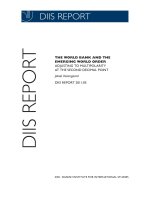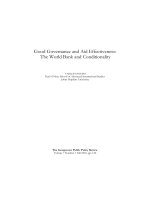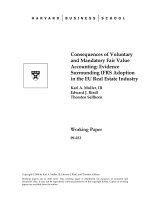The Million Person Gap: The Arab Population in the West Bank and Gaza docx
Bạn đang xem bản rút gọn của tài liệu. Xem và tải ngay bản đầy đủ của tài liệu tại đây (2.13 MB, 97 trang )
THE BEGIN-SADAT CENTER FOR STRATEGIC STUDIES
BAR-ILAN UNIVERSITY
Mideast Security and Policy Studies No. 65
The Million Person Gap:
The Arab Population in the
West Bank and Gaza
Bennett Zimmerman, Roberta Seid and
Michael L. Wise
The Begin-Sadat Center for Strategic Studies
Bar-Ilan University, Ramat Gan, 52900, Israel
ISSN 0793-1042
February 2006
Copyright 2005 Bennett Zimmerman and Roberta Seid, Ph.D.
All rights reserved
The Begin-Sadat (BESA) Center for Strategic Studies
The BESA Center for Strategic Studies at Bar-Ilan University was founded by Dr. Thomas O.
Hecht, a Canadian Jewish community leader. The Center is dedicated to the memory of Israeli
prime minister Menachem Begin and Egyptian president Anwar Sadat, who concluded the first
Arab-Israel peace agreement. The Center, a non-partisan and independent institute, seeks to
contribute to the advancement of Middle East peace and security by conducting policy-relevant
research on strategic subjects, particularly as they relate to the national security and foreign
policy of Israel.
Mideast Security and Policy Studies serve as a forum for publication or re-publication of
research conducted by BESA associates. Publication of a work by BESA signifies that it is
deemed worthy of public consideration but does not imply endorsement of the author's views or
conclusions. BESA Colloquia on Strategy and Diplomacy summarize the papers delivered at
conferences and seminars held by the Center, for the academic, military, official and general
publics. In sponsoring these discussions, the BESA Center aims to stimulate public debate on,
and consideration of, contending approaches to problems of peace and war in the Middle East. A
listing of recent BESA publications can be found at the end of this booklet.
International Advisory Board
Founder of the Center and Chairman of the Advisory Board: Dr. Thomas O. Hecht
Members: Prof. Moshe Arens, Mrs. Neri Bloomfield, Mrs. Madeleine Feher, Gen. Alexander
M. Haig, Ms. Marion Hecht, Mr. Robert Hecht, Hon. Shlomo Hillel, Sir Robert Rhodes James,
Mr. Isi Leibler, Sen. Joseph I. Lieberman, Mr. Robert K. Lifton, Maj. Gen. (res.) Daniel Matt,
Rt. Hon. Brian Mulroney, Prof. Yuval Neeman, Maj. Gen. (res.) Ori Orr, Mr. Seymour D.
Reich, Amb. Meir Rosenne, Hon. Yitzhak Shamir, Lt. Gen. (res.) Dan Shomron, Amb. Zalman
Shoval, Amb. Norman Spector, Mr. Muzi Wertheim
International Academic Advisory Board
Desmond Ball, Australian National University, Eliot A. Cohen SAIS Johns Hopkins University,
Steven R. David Johns Hopkins University, Yehezkel Dror Hebrew University, Lawrence
Freedman King's College, Efraim Karsh King's College, Robert J. Lieber Georgetown
University, John J. Mearsheimer University of Chicago, Bruce M. Russett Yale University
Research Staff
BESA Center Director: Prof. Efraim Inbar
Senior Research Associates: Dr. Zeev Bonen, Prof. Stuart A. Cohen, Dr. Gil Feiler, Dr.
Jonathan Fox, Eng. Aby Har-Even, Dr. Hillel Frisch, Prof. Eytan Gilboa, Dr. Rami Ginat, Dr.
Avi Kober, Prof. Amikam Nachmani, Amb. Itzhak Oren, Maj. Gen. (res.) Avraham Rotem,
Prof. Shmuel Sandler, Dr. Dany Shoham, Dr. Shlomo Shpiro, Dr. Max Singer and Prof. Gerald
Steinberg
Research Associates: Dr. Tsilla Hershco, Dr. Mordechai Kedar, Dr. Zeev Maghen, Dr. Jonathan
Rynhold, Dr. Ron Schleifer
Director of Public Affairs: David Weinberg
Program Coordinator: Hava Waxman Koen
Production Editor (English): Tamara Sternlieb
Production Editor (Hebrew): Alona Briner Rozenman
Table of Contents
Preface
Acknowledgements
Chapter 1: Introduction and Summary of Results…………………. 1
Chapter 2: Methodology and Sources………………………………
5
Chapter 3: The 1997 PCBS Model and Forecast………….……… 9
The PCBS Model……………………………………………….……… 9
Factor-by-Factor Analysis of the PCBS Model…………………….… 10
A. The PCBS 1997 Base
Population……………….……….…
10
B. PCBS Birth Assumptions: 1997-
2003……………………….
19
C. PCBS Death Assumptions: 1997-
2003… …………….…….
25
D. PCBS Immigration Assumptions: 1997-
2003… ……….…
26
E. The Neglected Factor - Migration to Israel: 1997-
2003…….
29
Chapter 4: Arab Population in the West Bank and Gaza in 2004….
31
Chapter 5: Evaluation of Results……………………………………. 35
Chapter 6: The PCBS Response and Revision…………….…….… 44
Chapter 7: Conclusions………………………………………………
52
Appendices…………………………………………………………… 67
Appendix A: The Original PCBS Model, ‘Demographic Indicators of
the Palestinian Territory, 1997-2015’ (Released in 1998)…… ……….
67
Appendix B: The Revised PCBS Model, ‘Summary Statistics,
Palestinian Territory, 1997-2015’ (Revised March 2005)……………
68
Appendix C: PCBS 1997 Census Standards………………….…….… 69
Appendix D: Summary of Birth & School Entry Data, 1990-2003……. 70
PA MOH Births at Original and Restated Levels,
1996-1998…
71
PA MOH Births Adjusted to Pre-Census Levels,
1999-2003….
71
PA MOH Retroactive Births vs. ICBS Births, 1990-
1993…….
72
Appendix E: Summary of International Migration Data, 1990-2003… 73
Appendix F: PA CEC Reports and Analysis……………………………
74
‘CEC Upcoming Presidential Elections’, January 8,
2005…….
74
‘Focus on Elections in East Jerusalem’, January 6,
2005….…
75
‘CEC Registers Over 67% of Eligible Voters’, October 14,
2004……………………………….…………………………
76
Study Calculations from CEC Data………….…………….… 78
Appendix G: PCBS Model Birth Rates Applied to Residents-Only
Population Base…………………………………………………………
79
Appendix H: West Bank Population Growth Using Jordanian and
Israeli-Arab Natural Growth Rates, 1967-2003…………………….…
80
Preface
This project was initiated and led by Bennett Zimmerman, a former
Strategy Consultant with Bain & Company. Mr. Zimmerman holds an
M.B.A. from Harvard Business School and has conducted numerous due
diligence audits on business and governmental organizations. Roberta P.
Seid, PhD, is a historian and former lecturer at the University of Southern
California. She is a researcher and consultant on Israeli history, particularly
on events surrounding Israel’s War of Independence. Dr. Michael L. Wise,
PhD, a physicist and expert in mathematic model techniques, is the founder
and director of a wide range of public and private companies in the United
States and Israel. The authors were engaged in both the primary research
and the evaluation of all data and the population figures derived in this
report.
The authors worked closely with the leaders of an Israeli research
team, Yoram Ettinger, a consultant to members of Israel's Cabinet and
Knesset and a former Minister in Israel’s Washington Embassy, and Brig.
Gen. (Ret.) David Shahaf, former Head of the Civil Administration in the
West Bank who co-led Israel's last demographic survey of the West Bank in
1990. The Israeli team also included Professor Ezra Zohar who has
published research papers on demographics in Israel since 1970, Dr. David
Passig, Head of the Graduate Program of Communication Technologies and
an expert in forecasting at Bar-Ilan University, and Avraham Shvout, a
demographer who has tracked both Jewish and Arab population in the West
Bank. The Israeli research team collected primary data and reports that
assisted the American team in its research and analysis. As the Israeli team
included individuals who performed Israel’s last population work for the
West Bank and Gaza, they were well positioned to obtain vital information
and had first-hand experience with demographic analyses of the West Bank
and Gaza.
The authors appreciated the contribution of the Israeli research team but
take full responsibility for the work as it is presented in this document.
Acknowledgments
The authors are, first and foremost, grateful to Dr. Nicholas Eberstadt for
his invitation to debut our findings at the American Enterprise Institute on
January 10, 2005. It was the first stop of a very exciting journey for much of
2005. Murray Feshbach of the Wilson Institute and Jim Philips of the
Heritage Foundation also receive our appreciation, as well as Ambassador
John Bolton, for opening the first door in Washington.
We would like to thank Yuval Steinitz, Chairman of the Knesset Foreign
Affairs and Defense Committee and Dr. Yuri Stern, Chairman of the
Government Operations Committee, for their courtesy and professionalism
in providing the first public forums in which diverse opinions about
demography were presented and welcomed, Dr. Yitzhak Ravid for his
active review of our work and helpful feedback, and Professor Sergio
DellaPergola, whose critical remarks challenged and ultimately
strengthened our work and our conclusions.
The authors could not have completed this study without Yoram Ettinger
and the rest of our Israeli Team whom we thank for finding the facts and
opening doors for us in Israel. We especially appreciate the support of Prof.
Efraim Inbar for his close readings of our manuscript and his suggestions,
which were always on the mark. We also thank Kent Klineman, Heather
Lobenstein, and Tamara Sternlieb for their careful editing.
Many thanks to Ruthi Blum and Caroline Glick who provided unique
insight and perspective to our work, and to Haim Rosenberg, Yakov Maor
and Moshik Kovarsky in Israel and Gary Ratner, Alyson Taylor, Esther
Kandel, Avi Davis, Samuel Appelbaum, Roz Rothstein, Peter Mandel,
Blossom Siegel, and Harvey Karp in the USA.
Arnold Seid, Michael Seid, Batya Wise and the extended Wise and Seid
clans – thanks always. And finally, thanks to the ‘demographic mom’, Dr.
Ester Fiszgop.
Chapter 1: Introduction and Summary of Results
This study assesses the source and veracity of population reports issued
annually by the Palestinian Authority (PA) since 1997. The goal is to
calculate an accurate population estimate for the West Bank and the Gaza
Strip (the Territories) through mid-year 2004.
The Israel Central Bureau of Statistics (ICBS) had been responsible for
recording population data in the Territories during Israel’s Civil
Administration from 1967 until 1994-1995 when, in conformity with the
1993 Oslo Accords, it transferred this responsibility to the PA and ceased its
own work. The PA established the Palestine Central Bureau of Statistics
(PCBS) to perform this function. In 1997, it conducted its first census and
used the results to develop population growth projections for each year from
1998 to 2015.
1
It is these predictions that the PA has officially issued each
year as its population size. These statistics have been routinely accepted by
Israeli government agencies, the UN, the World Bank, the EU, the US State
Department, and many demographers have used the PCBS data for their
own projections.
2
However, the PCBS methodology, statistics, and
assumptions have never been fully examined or evaluated.
This study examines the 1997 Census, both in its definition of de facto
residents and against other population estimates from that era, and compares
the PCBS projections to actual reported births, deaths and immigration
recorded annually by official Palestinian and Israeli agencies. In this
research, the West Bank population does not include Arabs living inside the
Israeli-designated municipal boundaries of Jerusalem. This population is
already recorded by the Israel Central Bureau of Statistics (ICBS) in its
population surveys of Israel. This study reveals major discrepancies in the
PCBS forecast.
The 1997 PCBS beginning population base for de facto residents was
inflated by:
• Inclusion of Non-residents: The 1997 PCBS Census base included
325,000 Palestinian Arabs living abroad, even though these
individuals had lived outside the Territories for many years. This
group comprised 13% of the PCBS’ reported population base.
Reduction: 325,000
MIDEAST SECURITY AND POLICY STUDIES
2
• Inclusion of Jerusalem Arabs in West Bank Figures: Jerusalem
Arabs who were already counted in Israel’s population survey were
also counted in the PCBS population estimate for the West Bank.
Reduction: 210,000
• Unexplained Increase over ICBS Records: The 1997 PCBS census
included an additional 113,000 rise above the last ICBS figures for
the Territories. Yet, PA Central Election Commission reports for
adults voting in 2005 substantiated the ICBS population records
from the mid-1990s. Reduction: 113,000
The PCBS Model’s projections with respect to births and immigration were
not met in any year between 1997 and 2004.
• Fewer Births: According to reports current through January 2005,
the PA Ministry of Health recorded fewer annual births between
1997 and 2003 than the PCBS had predicted for each of those years.
These lower birth figures are consistent with PA Ministry of
Education figures for students entering school six years later.
Reduction: 238,000
• Alterations of Recorded Birth Data: In its more recent reports, the
PA Ministry of Health retroactively raised the number of births it
had reported prior to the release of the 1997 PCBS census. Using
data at originally reported levels lowers the number of births even
further. Reduction: 70,000
• Net Immigration and Emigration Error: Instead of the large
immigration originally forecast by the PCBS, the Territories
experienced a steady net emigration abroad. The PCBS predicted
236,000 would move into the Territories between 1997 and 2003.
Instead, 74,000 left. Reduction: 310,000
• Migration to Israel: Many residents of the Territories moved to pre-
1967 Israel and Jerusalem. No adjustments were made for unofficial
immigration as there is little data on this group. However,
THE MILLION PERSON GAP
3
immigrants who legally received Israeli IDs according to Israel
Ministry of Interior reports from 1997 to 2003 were removed from
the PCBS count. Reduction: 105,000
When adjusting for the PCBS errors, the Arab population in the Territories
at mid-year 2004 was calculated at 2.49 million rather than the 3.83 million
reported by the PCBS – a gap of 1.34 million persons. As a consequence,
the population growth rates were considerably lower than has been
assumed. Taken together, these overestimates by the PCBS compounded
exponentially to produce a 50% overstatement of the 2004 Arab population
in the Territories.
Figure 1.1 shows the differences between the PCBS Model and the results
of this study and the relative importance of each category in forming the
gap.
Since the results of this study were released on January 10, 2005, the PCBS
has acknowledged some errors in its population model and has begun to
lower both its current population estimate and its predictions about its future
size.
3
This report also addresses those recent revisions and the PCBS
response to this study.
Figure 1.1 Differences between PCBS Model and this Study’s Results by Mid-Year 2004
4
Millions of People
4.0
3.5
3.0
PCBS Model:
3.83 Million Total
2.42 Million West Bank
1.41 Million Gaza
2.5
2.0
PA MOH Births
238K
Birth Alterations
70K
Deaths
33K
Immigration &
Emigration Error
310K
Migration to Israel
Inclusion of
Jerusalem Arabs
210K
Residents
Living Abroad
325K
Jump Over ICBS
113K
Study Results:
2.49 Million Total
1.41 Million West Bank
1.08 Million Gaza
105K
“The 1.34 Million
Person Gap”
THE MILLION PERSON GAP
5
Chapter 2: Methodology and Sources
The formula for measuring population is straightforward. After a beginning
base population is determined, births and immigration in a given period are
added and deaths and emigration are subtracted, producing a new base
population at the end of the period. Expressed arithmetically, the formula is:
Begin Population + Births – Deaths + Immigration – Emigration = End
Population
Measuring any population requires accurate reporting and verification of
each of these factors. This study investigated, factor-by-factor, the actual
data released by Palestinian and Israeli agencies since 1990. Third party
data was used for comparative purposes.
It is important to underline that this study used a bottom-up approach.
Population calculations were based on a verified beginning population base
and carefully researched data on actual annual births, deaths and migration.
These results represent a historical analysis of demographic events that have
already occurred. The calculation ends with 2004 and does not make
projections about future population size or growth rates.
The population results in this study were corroborated with statistical
indicators, including election and school enrollment data, and with earlier
projections and comparisons against regional and world population trends.
Spectrum Demographic Software was used to verify that the arithmetic
models produced in this study matched conventional demographic patterns
in which there is consistency between population size, fertility rates and
birth levels.
5
In contrast, many other demographic studies have employed a linear
approach in which rough or outdated growth assumptions are applied year
after year to a base population to arrive at new population estimates. If the
population base and/or the rates are inaccurate, the results become seriously
flawed. The errors in growth assumptions compound as they are applied to
future years. The resulting models begin to diverge, exponentially, from the
actual situation on the ground. Unless those who make such predictions
MIDEAST SECURITY AND POLICY STUDIES
6
correct their errors about present population size and growth rates, their
assessments about the future are meaningless.
Real Data Yields Real Growth Rates
This study did not use projected or estimated rates to calculate any
population figures. Instead, it used data about demographic events that had
occurred in previous years to construct a more accurate current population
estimate for the Territories. This data was, in turn, used to calculate actual
growth rates for the population in the West Bank and in Gaza. This study
reports population growth rates released each year by relevant PA agencies
for informational and comparative purposes only. These rates are often
wrong since they were estimated in earlier years or depend on previous and
often incorrect forecasts for population in the Territories.
Annual population growth rates (PGRs) are calculated as the difference
between the population base at the start and end of a year. Birthrates and
death rates reflect the number of births or deaths per year as a percentage of
the total population at the start of a year. Natural growth rates (NGRs) are
equal to the annual birth rate less the annual death rate for a particular year.
Total fertility rates (TFRs) measure the average number of children a
woman is likely to have during her childbearing years if birth rates remain
stable.
Sources
The primary sources used in this research were taken from PA agencies
actively engaged in recording demographic events in the West Bank and
Gaza. Data from each of these agencies was compared for consistency. The
PA sources include:
• Palestinian Central Bureau of Statistics (PCBS): The PCBS
conducted the 1997 census and issued population projections
through 2015.
6
• Palestinian Ministry of Health (PA MOH): Since 1996, the PA
MOH has kept detailed records on births and deaths, including the
THE MILLION PERSON GAP
7
district where a birth occurred, the type of delivery, whether it took
place at home or in a hospital and other facts.
7
• Palestinian Central Election Commission (CEC): The CEC has
issued reports on the number of eligible voters, aged 18 and above.
The CEC issued these statistics for the parliamentary elections in
1996, the municipal elections scheduled for October 2004 and the
presidential elections held in January 2005.
8
• Palestinian Ministry of Education (PA MOE): The PA MOE
reported the number of children entering school each year and the
number enrolled at each grade level. This information was used to
test birth data of children born in earlier years.
9
Several Israeli agencies have critical information about the Arab population
in the Territories from 1967 to the mid-1990s when Israel turned over most
administrative functions to the PA. Israel continues to maintain border and
migration statistics. The Israeli sources include:
• Israel Civil Administration for the Territories/Israel Central
Bureau of Statistics (ICBS): As the civil administrator of the West
Bank and Gaza, Israel performed an official census in 1967, kept
official population records, issued IDs, kept health, inoculation and
school records, and made demographic projections. In 1987, Israel
updated the population registry of Gaza after the exchange of all ID
cards. In 1989-90, Israel performed a study of the West Bank in
which population estimates were compared against independent
sources such as the registration of residents, manpower surveys,
student records and other measures. The ICBS continued to issue
internal reports, which were obtained for this study, estimating the
population for both the West Bank and Gaza through the end of
1996. This study relies on the ICBS for all population statistics on
Israeli Jewish and Arab citizens residing within areas of Israeli
jurisdiction.
10
• Israel Border Police: Under the Oslo Accords, Israel continued to
control the border crossings to Jordan and Egypt and to monitor the
MIDEAST SECURITY AND POLICY STUDIES
8
Palestinian Arabs who used Ben-Gurion Airport to travel in and out
of Israel. Consequently, the Israel Border Police has detailed records
of exits and entries at all international borders for Israel, the West
Bank and Gaza.
11
• Israel’s Ministry of the Interior maintained ID records for the West
Bank and Gaza until the end of Israel’s civil administration when
they were turned over to the PA. The Ministry currently tracks the
ID cards issued to immigrants from the West Bank and Gaza who
have legally moved into pre-1967 Israel and Jerusalem. This data is
a partial measurement of PA residents who have immigrated into
Israel.
12
The agency does not track unofficial, or illegal, migration
from the Territories into Israel.
Many international agencies provide insights into various aspects of the PA
population. The United Nations Relief Works Agency (UNRWA) keeps
detailed records about Palestinian refugees,
13
and the World Bank
14
has
sponsored multiple programs that include analysis of the Arab population in
the West Bank and Gaza.
The CIA World Factbook
15
and the UN
Population Agency
16
are additional sources of regional and world statistics.
THE MILLION PERSON GAP
9
Chapter 3: The 1997 PCBS Model and Forecast
The PCBS Model
On the night of December 9-10, 1997, the PCBS completed its first census
and enumerated a population of 2.602 million Arabs living in the West
Bank and Gaza. After adjusting for a post-enumeration of 83,000
individuals (i.e. adjusting for data not fully recorded during the census) and
adding 210,000 residents living in eastern Jerusalem, the PCBS released a
final mid-year 1998 population figure of 2.895 million for Arabs living in
the Territories. When it released the final results, the PCBS also published a
backdated figure for mid-year 1997 of 2.783 million.
17
The PCBS then used
the results of the census as the basis to construct projections about the
expected size of the population for each year from 1998 to 2015. In 1998, it
summarized this forecast in Demographic Indicators of Population 1997-
2015. (This document is included as Appendix A.)
By assuming high birthrates, low death rates, and massive immigration
rates, the PCBS projected a compound annual population growth rate of
4.75% between 1997 and 2004 for the Territories. The PCBS also forecast
that birthrates of 4.27% in 1997 would begin a gradual decline to 3.92% by
2003. Numerically, these births rates led to growing projections from
119,000 births in 1998 to 143,000 by 2003 as they were applied to a rapidly
expanding population base.
18
The PCBS assumptions about immigration proved to be the most significant
factor accelerating growth in its population model. The PCBS projected that
immigration would progressively increase, from a level of approximately
14,000 immigrants in 1998 to more than 50,000 per annum beginning in
2001. This assumption led the PCBS to raise its annual population growth
rates even while it projected a decline in birth rates. The PCBS projected
overall population growth at 4.11% for 1997, with 3.79% from natural
growth (4.27% birth rate less 0.48% death rate) and 0.32% from
immigration. By 2003, the PCBS anticipated that overall annual growth
would rise to 4.94% as immigration expectations jumped dramatically to
1.43% per annum even while natural growth was expected to decline to
3.51% (3.92% birth rate less 0.42% death rate). It has become almost
Figure 3.1 Population Data Derived from PCBS Model, 1997–2004, (Model current through January 2005)
19
Figures in bold are taken directly from the PCBS Model. Figures in normal text are derived from the PCBS Model.
(Mid-Year)
1997
-
1998
1998
-
1999
1999
-
2000
2000
-
2001
2001
-
2002
2002
-
2003
2003
-
2004
Population Base for West Bank & Gaza
including eastern Jerusalem
2,783,084 2,897,452 3,019,704 3,150,056 3,298,951 3,472,121 3,647,875
Crude Birth Rate
4.27% 4.20% 4.14% 4.07% 4.01% 3.99% 3.92%
Crude Death Rate
0.48% 0.47% 0.45% 0.44% 0.43% 0.43% 0.42%
Natural Growth Rate
3.79% 3.74% 3.68% 3.63% 3.59% 3.56% 3.51%
Migration Rate
0.32% 0.48% 0.63% 1.09% 1.66% 1.50% 1.43%
Population Growth Rate
4.11% 4.22% 4.32% 4.73% 5.25% 5.06% 4.94%
Births in PCBS Model
118,810 121,722 124,865 128,270 132,420 138,433 143,106
Deaths in PCBS Model
-13,303 -13,473 -13,619 -13,797 -14,087 -14,826 -15,175
Migration in PCBS Model
8,861 14,003 19,106 34,422 54,837 52,146 52,108
Ending Residential Base
2,897,452 3,019,704 3,150,056 3,298,951 3,472,121 3,647,875 3,827,914
THE MILLION PERSON GAP
11
axiomatic to describe the West Bank and Gaza as regions with the “highest
growth rates in the world”.
20
Even though the PCBS projected gradually
falling birth rates, it nonetheless forecast extraordinary growth rates built on
assumptions of heavy immigration into the West Bank and Gaza. (See the
PCBS model, Demographic Indicators of the Palestinian Territory,
included as Appendix A.) Figure 3.1 explicitly computes the births, deaths
and immigration contained each year in the original PCBS projection.
The PCBS reported a mid-year 2004 population of 3.827 million, exactly
the same number forecast in 1998.
21
And, in fact, the PCBS population
figures, released each year since 1998, have always been a reiteration of a
forecast made shortly after the publication of the 1997 Census results. The
PCBS, until after the release of this study on January 10, 2005, never
adjusted any of these figures to reflect actual reported demographic events.
Factor-by-Factor Analysis of the PCBS Model
In this section, the accuracy of the PCBS model is examined. First, the
census base itself is investigated, including the definitions adopted by the
PCBS and their implications. In addition, the population base is compared
with measurements from the ICBS and other Palestinian agencies. Second,
the births, deaths and immigration forecast by the PCBS is compared with
records of actual events that occurred in each of the seven years beginning
in 1997 and ending in 2003. This factor-by-factor analysis provides the data
required to calculate an accurate population figure for the West Bank and
Gaza for each year since 1997.
A. The PCBS 1997 Base Population
Before Census: Prior to the PCBS Census in December 1997, Israeli and
PA estimates for the Arab residential population in the Territories,
excluding eastern Jerusalem, were similar. The last ICBS internal estimate
was 2.111 million at the end of 1996.
22
The PA Ministry of Health (MOH)
released its own population estimate for 1996 of 2.270 million, only
159,000 higher than the Israeli figure.
23
(See Figure 3.2.)
MIDEAST SECURITY AND POLICY STUDIES
12
Figure 3.2 West Bank and Gaza Population Estimates, 1993-1996
24
(In Thousands)
ICBS
1993
ICBS
1995
ICBS
1996
PA MOH
1996
West Bank
1,084
1,199
1,237
1,317
Gaza
748
842
874
953
Total
1,832
2,041
2,111
2,270
Census Era: In 1998, the PCBS published the results of its December 1997
Census which enumerated 2.602 million individuals in the West Bank and
Gaza. From the census data, the PCBS estimated a mid-year 1998
population of 2.895 million for the West Bank and Gaza and issued a
backdated estimate for a mid-year 1997 population of 2.783 million.
25
This
mid-year 1997 figure became the starting point for the PCBS population
projections. (See Figure 3.3.)
Figure 3.3 Results of PCBS 1997 Census
26
(In Thousands) West Bank
Gaza
Total
Population Enumerated in December
1997 Census
1,602
1,000
2,602
Post-Enumeration
63
21
84
Eastern Jerusalem Arabs
210
210
Total Mid-Year 1998
1,875
1,021
2,896
Total Backdated to Mid-Year 1997
1,787
996
2,783
Thus, with the publication of these results, the gap between the PCBS and
ICBS figures widened dramatically. In December 1997, the ICBS compiled
its last internal report for Arab population in the Territories for year-end
1996 as 2.111 million.
27
When the ICBS year-end figures are brought
THE MILLION PERSON GAP
13
forward by six months to a mid-year 1997 estimate of 2.135 million (22,000
in half-year growth based on PA MOH and Israel Border data), the PCBS
mid-year 1997 estimate of 2.783 million is a full 648,000 higher than ICBS
measurements.
Inclusion of Eastern Jerusalem Arabs
210,000 of the gap arose from the PCBS decision to include Arabs living in
eastern Jerusalem in 1997. While the Oslo Accords restricted the PCBS
activities to areas outside the Israeli-defined municipal boundaries of
Jerusalem, the PCBS considers eastern Jerusalem part of the West Bank. As
a result, the PCBS included the figures for eastern Jerusalem Arabs, as
reported in ICBS population surveys, in its own estimates for the West
Bank population.
28
Excluding these eastern Jerusalem Arabs, the PCBS
mid-year 1997 estimate of 2.573 million exposed a remaining 438,000 gap
between ICBS and PCBS population estimates for the West Bank and Gaza.
Figure 3.4 summarizes the gaps that arose between ICBS and PCBS data
by mid-year 1997.
Did the Israelis undercount or did the PA over count? The answer lies not in
a major counting difference but rather in different definitions of who was
considered a de facto resident of the Territories.
Inclusion of Non-Residents
During Israel’s Civil Administration of the Territories, there were
differences between population calculations based on the registry of ID and
birth records maintained by Israel’s Ministry of Interior and those based on
records from the ICBS which regularly estimated the population of de facto
residents actually present in the Territories at any given time. According to
the Civil Administration Survey of 1989, this discrepancy could be
attributed to two factors:
“The Ministry of Interior registers 1.328 million [in the West Bank],
while the ICBS estimates that the total is 904,000. The ICBS
assumes that there are two causes for the gap: (a) The Ministry of
MIDEAST SECURITY AND POLICY STUDIES
14
Interior does not deduct the 163,000 who reside abroad; (b) Death
data for infants and adults are lacking.”
29
The lower ICBS count was confirmed by the number of ID cards issued to
residents in 1989. The number of residents was found to be a full 32% less
than the Ministry of Interior records which included former residents and
those who had never been removed upon death, and in its 1987 study of the
Gaza population, the Civil Administration noted that 8% of the population
records maintained by the Ministry of Interior for Gaza, or approximately
50,000, were overseas residents and their offspring.
30
The PCBS Census included Palestinian-Arabs who were living abroad but
misclassified them as de facto residents. A census that includes persons
normally residing in an area who are temporarily elsewhere at the time of
the enumeration is classified as a de jure census. A de facto census counts
only individuals actually present in the area at the time of enumeration.
31
The PCBS stated in its Census Standards (included as Appendix C) that it
was performing a de facto census, but it also explicitly stated that it
expanded the definition to include persons who have “lived abroad for more
than one year… and have identity cards… irrespective of the purpose of
stay abroad”.
32
In other words, anyone who had ever received an ID card
from the PA or from Israel during the Civil Administration was included as
a de facto resident in the census. In a March 1998 news conference, Masur
Hassan Abu-Libdeh, head of the PCBS, specified the number of
Palestinians living abroad who were included in the census:
“We counted 325,000 people living outside of the Palestinian Lands
for more than one year, who carry Palestinian ID cards and can
return at any time.”
33
This 325,000 count of residents living abroad represented 13% of the total
mid-year 1997 population count of 2.573 million issued by the PCBS for
the West Bank and Gaza, not including eastern Jerusalem.
The practice of including residents living abroad is common at other PA
agencies as well. In an October 14, 2004 press release, the PA Central
Election Commission (CEC) specifically noted “approximately 200,000
THE MILLION PERSON GAP
15
eligible voters [those 18 years old and older] live abroad”.
34
The 200,000
comprised 13% of the 1.5 million total eligible voters, the same percentage
found in analysis of the 1997 PCBS data. The CEC report therefore
indicates a de facto adult residential population in the Territories of 1.3
million persons. These figures were consistent with the election data
released by the CEC on January 8, 2005, one day before the PA Presidential
Elections.
35
(See Appendix F for CEC Reports)
In 1993, the World Bank corroborated these figures when it reported that
350,000 of the Palestinian population (adults and children) lived abroad. It
further noted that 199,000 of this group had kept their IDs current while the
remainder had not.
36
Figure 3.4
Gaps between ICBS and PCBS Population Estimates for
West Bank and Gaza, 1996–1997
37
4.0
3.0
2.0
1.0
0
Millions of People
June
1997
PCBS 1997 Census
(PCBS backdated
to Mid-Year 1997)
2.783 Million
2.111 Million
December
1996
ICBS
Report
+210K Jerusalem Arabs
+438K Census Increase
325K Residents Abroad
113K Additional Increase
2.135 Million
June
1997
ICBS
Report
(Updated
to Mid-Year 1997)
MIDEAST SECURITY AND POLICY STUDIES
16
Remaining Difference between PCBS and ICBS
After removing the 325,000 acknowledged by the PCBS in 1998 as
residents living abroad from the 438,000 gap identified between mid-year
1997 PCBS and ICBS estimates, the two agencies were only 113,000
persons apart.
The CEC data reflecting a 1.3 million de facto adult resident population in
the West Bank and Gaza in 2004 provided an opportunity to evaluate
population base claims made by different agencies in earlier years. For
example, the number of individuals aged 11 and older in 1997 should
predict the number of eligible voters who will be 18 and older seven years
later in 2004 after adjustments are made for deaths and migration.
38
Consequently, an accurate population pyramid (or age distribution model)
from 1997 should match the current voter rolls.
The CEC data was used to test both the current PCBS adult population
claims and the number of adults implicitly predicted by earlier population
pyramids from the 1990s after they were adjusted for deaths and
migration
39
:
1) The PCBS census base and forecast, including projected deaths
and immigration, predicted 1.85 million adults in the Territories
by 2004.
2) The PCBS census base and associated population pyramid, with
actual death and migration data, predicted a population of 1.5
million adults by 2004.
3) The PA MOH 1996 population pyramid predicted a population
of 1.4 million adults by 2004.
4) The ICBS 1993 population pyramid predicted a population of 1.3
million adults by 2004.
40
As shown in Figure 3.5, the CEC data invalidated the original PCBS
forecast, which had projected 1.85 million voting-age adults in the
Territories by 2004. The CEC information on total eligible voters confirmed
that the 1.5 million adults for 2004 anticipated by the 1997 PCBS census
Figure 3.5
Central Election Commission Eligible Adult Voters vs. Adults Predicted by Various Population
Models for 2004
87%
Resident
13%
1.5 M
1.4M
1.5M
1.3M
1.85M
1.3M
ICBS
+ 11 Years
PA October2004
Voting Report
• 1.3 Million Eligible Voters
Resident in the Territories
• 200K Eligible Voters
Living Abroad
PA MOH
+ 8 Years
PCBS
+ 7 Years
PCBS
(2004)
2.5
2.0
1.5
1.0
0.5
0
Millions of People









